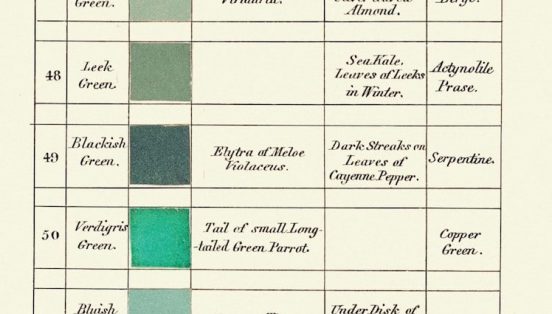In a direct line, from Abraham Gottlob Werner, the “Father of German Geology” to a color of chile peppers and one of the problems with chilli varieties, considering their history?
How so?
A Pantone of 1850’s Naturalists
Werner’s Von den äusserlichen Kennzeichen der Fossilien (On the outer characteristics of fossils) formed the basis on which the Scottish painter Patrick Syme and the (also Scot) naturalist Robert Jameson created Werner’s Nomenclature of Colours.
The work – only recently presented on the Metropolitan Museum of Art website, and available for purchase as a paperback facsimile published by Smithsonian Books – illustrates the various colors that can be found in nature, all with a color swatch, as well as examples for their appearance among animals, plants and minerals.
None other than Charles Darwin was among the users of the book (as nicely described by The New Yorker)…
Chilli in the Nomenclature of Colours
I notice, of course, where the chilli gets mentioned:
Interestingly, not among the reds.

Blackish-green, however, is mentioned as the color which can be found in the “dark streaks on leaves of cayenne pepper”.
Sure, it is the slightest of mentions. One has to be the ChiliCult-ist (and someone also writing about “Seeing More,” about the things which are usually overlooked) to notice.
Es ist aber auch interessant.
Chilli in Art, Chilli in its Development
Some different colorations, e.g. in the leaf area versus its veins, or with the dark violet/black-colored leaves that sometimes occur, are to be found among the chile pepper.
As clearly a different coloration in streaks of cayenne pepper leaves as described in the Nomenclature, on cayenne, though? Can’t say that I’ve noticed anything like that.
Artists have rarely painted the chile pepper, whether as a plant or as pods; botany has given us some illustrations – but these are just what makes a closer look all the more interesting.
Especially for this reason:
We tend to care about heirloom varieties, traditional peppers, in all their diversity quite a bit. Maybe also with the changes happening with it… and when one looks at such old depictions, one finds some types of chilli that are easy enough to recognize.
There are also cases, and many of them, where the chile peppers that were painted look nothing like anything known. Has something changed? Or were the illustrators not as interested in detail and exactness as in just showing something?
In Werner’s Nomenclature of Colours, the look at the details certainly was exact – but what were they seeing in the Cayenne pepper? Or, did something happen and change it?
The book can, by the way, be found on archive.org (scanned from an original) – or be bought in the paperback-sized reprint made by Smithsonian Books (here with affiliate link to amazon.com which might bring me a few cents if you ordered it following that link).

Leave a Reply
You must be logged in to post a comment.